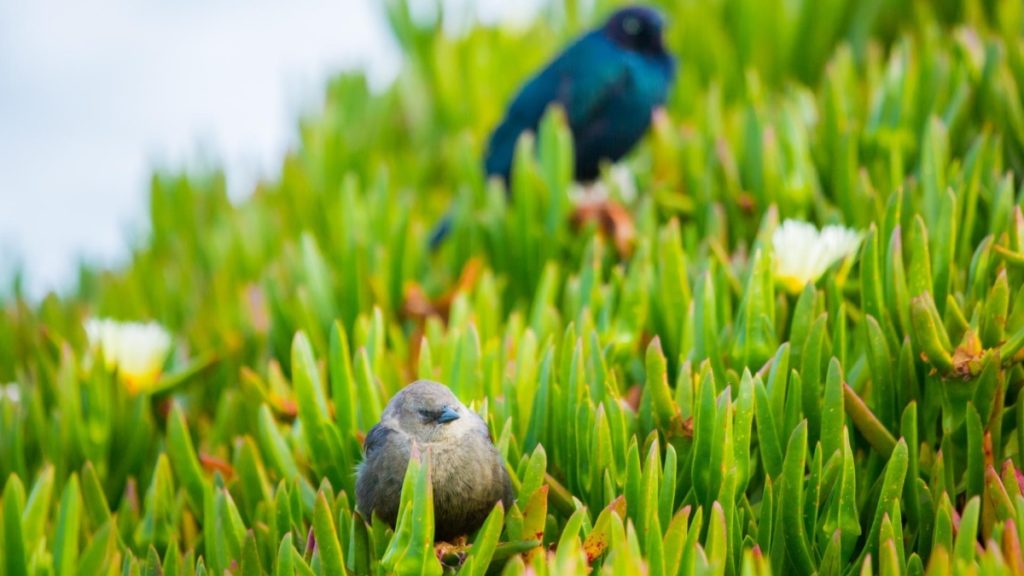
Living or visiting California and wondering what bird you’re looking at? This article covers common birds of California. Odds are high the bird you’re looking at is one of them. It will also inform you on how to identify them.
There are more than 660 different types of bird species living in California, a state with a diverse landscape spanning from the Mojave Deserts to an 840-mile coast, to marshes and forest. Birding in California has the added benefit of some of the best scenery in the country. Two species are native to the state and can only be found here – the Yellow-billed Magpie and Island Scrub-Jay, making them genuine birder treasures.
Where to Begin a California Birding Adventure
The Klamath Basin National Wildlife Refuges Complex is a large grassland area that has an abundance of waterfowls and waterbirds, as well as raptors such as the Bald Eagle, Prairie Falcon, and the Peregrine Falcon.
The Arcata Marsh and Wildlife Sanctuary in northern California between Highway 101 and Arcata Bay has more than 300 species of birds, and the center can help provide advice as to recent sightings. This is another excellent birding site for shorebirds such as geese and ducks. There are also regular sightings of the Virginia Rail and Sora Rail. Birder will delight in spotting rare birds such as the Sharp-tailed Sandpiper and the Bair-tailed Godwit.
The Point Reyes National Seashore qualifies as one of the best birding spots in the country. There are seabirds as well as California Quail, Nuttall’s Woodpecker, Anna’s Hummingbird, and other land birds. Excellent choices for birding are the Bear Valley and the Earthquake trails. The Bolinas Lagoon in the south brings plenty of shorebirds and waterfowl.
The nearby Giacomini Wetlands is home to waterfowl, shorebirds, and waders. Birders can check out Abbott’s Lagoon off Pierce Point Road and Point Reyes Station.
The Elkhorn Slough National Estuarine Research Reserve, located between Santa Cruz and Monterey is another paradise for birders searching for shorebirds and waterfowls. Snowy Plovers endeavor to hide from people, but don’t always succeed. Head south for the Point Pinos lighthouse for cormorants, loons, gulls, and the Black Oystercatcher.
The Golden Gate National Recreation Area/Marin Headlands are located north of San Francisco.
The Rodeo Lagoon is a spot for waterfowls and waders. During the fall Hawk Hill can be filled with various species of hawks.
Mono Lake, one of the oldest lakes in the Americas, has more than 230 different species of birds, especially the Eared Grebes, Wilson’s Phalaropes, and Red-necked Phalaropes.
Hiking through the San Gabriel Mountains brings a combination of wonderful scenery and aviary abundance. The Switzer picnic area is home to Mountain Quails, Acorn Woodpeckers, Pacific-slope Flycatcher, Anna’s Hummingbird, and others. Continue to ascend for sightings of the Nuttal’s and White-headed Woodpeckers, several finches, and the Mountain Chickadee.
Most Common Birds of California
Dark-eyed Junco
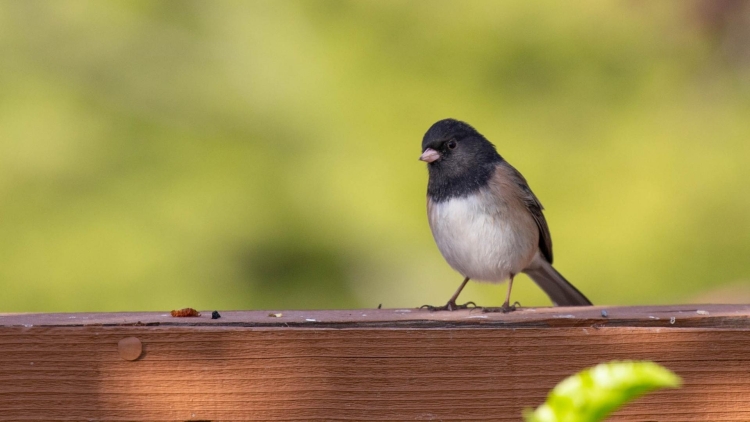
The Dark-eyed Junco is a very common bird with a round head, a short bill, and a long tail. They grow between 5.5 to 6.3 inches in length and weigh between 0.6 and 1.1 ounces with a wingspan between 7.1 and 9.8 inches. They may vary in color, but generally, they are shades of gray or brown with a pink bill and white tail feathers. They live in coniferous and mixed-coniferous forests but spend their time on the ground in search of fallen seeds.
Allen’s Hummingbird
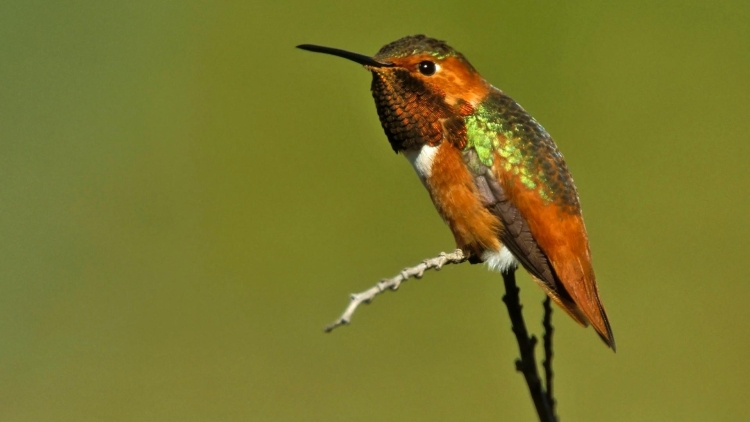
The Allen’s Hummingbird grows up to 3.5 inches and weighs 0.1 ounces with a wingspan of 4.3 inches. The male has a spectacular overall coppery shade, with a bronze back and reddish-orange throat, while the female has a bronze-green body and pale copper sides. They live in coastal woodland and scrubs near the coast and feed on insects and drink the sweet nectar from flowers. The male uses his orange coloring during courtship displays.
California Towhee
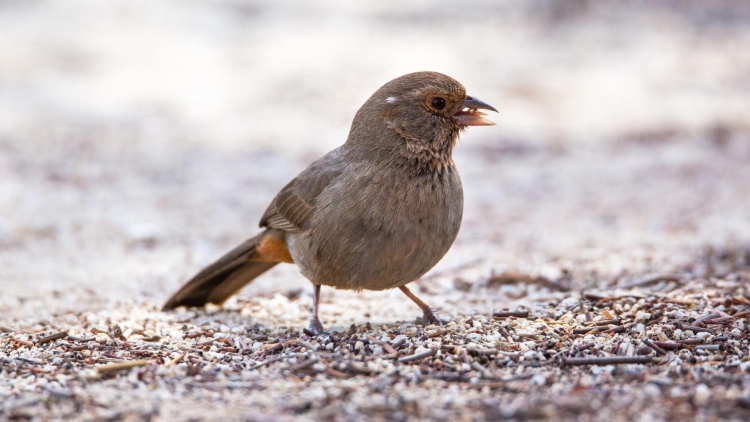
The California Towhee are large sparrow-type birds with short, rounded wings, a long beak that cracks seeds, and a long tail. They grow in length between 8.3 to 9.8 inches, weigh 1.3 to 2.4 ounces with a wingspan of 11.4 inches. Except for a rust-colored area on their tail, they are almost totally matte brown.
They live in backyards, parks, and shrubby areas and forage on the ground, where they feed on seeds and insects. During the summer, they add berries and small fruit to their diet.
Cedar Waxwing

The Cedar Waxwing has a large head, a short neck, and a short, broad bill. They grow between 5.5 and 6.7 inches in length, weigh 1.1 ounces with a wingspan between 8.7 and 11.8 inches. Their head is a pale tan sporting a crest, and their chest is a light gray with a yellow belly. The gray tail has a distinctive yellow tip, while the wing feathers have a noticeable bright red tip. The shade of red is determined by the type of berries they have eaten. The Cedar Waxwing’s face has a black mask that is outlined in white.
They are known to become disoriented and drunk and fly into glass after consuming fermented berries such as fermented blackberries, juniper berries, or crabapples. During the summer, their “alcohol-fueled” diet is enhanced with insects.
They build their nests in fruit trees not far above the ground. In California, they are drawn to backyards with fruit trees, such as coffeeberry.
Chestnut-backed Chickadee
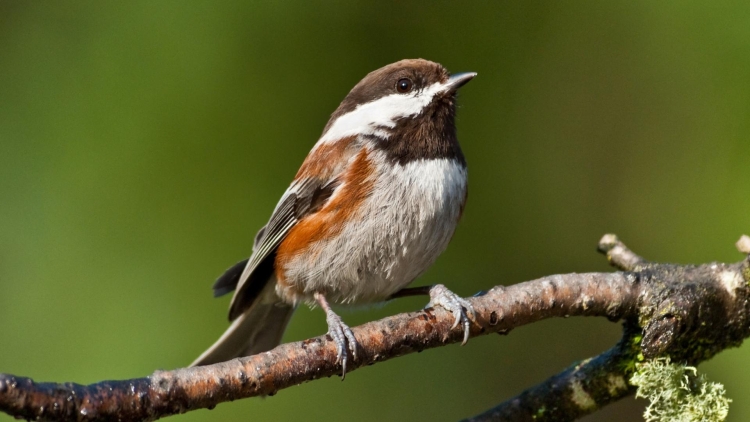
The Chestnut-backed Chickadee is a small bird with a large head, a small bill, short wings, and a long tail. They grow between 3.9 and 4.7 inches in length, weigh between 0.3 and 0.4 ounces with a wingspan of 7.5 inches. This Chickadee has a striking black cap with a bold white line around the neck. The back is a rusty chestnut. In Northern California, the flanks are brown, while in Sothern California, the flanks are gray. They can also be found in the Sierra Nevada mountains.
They live in coastal coniferous forests and nest inside of tree cavities and feed on insects, seeds, and berries. They will also snatch up caterpillars and spiders.
Common Birds by Color
Black Birds in California
Black-and-white Warbler in California
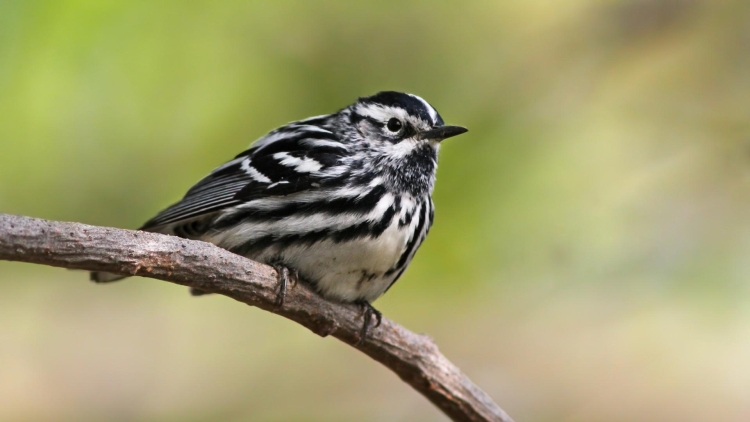
The Black and White Warbler is a small songbird with a long, thin bill. They have long wings and a short tail, and their entire body is uniformly striped black and white – like little avian jailbirds. These stripes make them relatively easy to identify. They grow between 4.3 and 5.1 inches in length, weigh between 0.3 and 0.5 ounces with a wingspan between 7.1 and 8.7 inches.
Their habitats are forests and forest edges, and they nest at the base of a tree while they hunt for insects hiding in tree barks. The Black and White Warbler can be seen in California during the spring migration period – although ambitious birders have spotted a few of them during the winter.
Painted Redstart
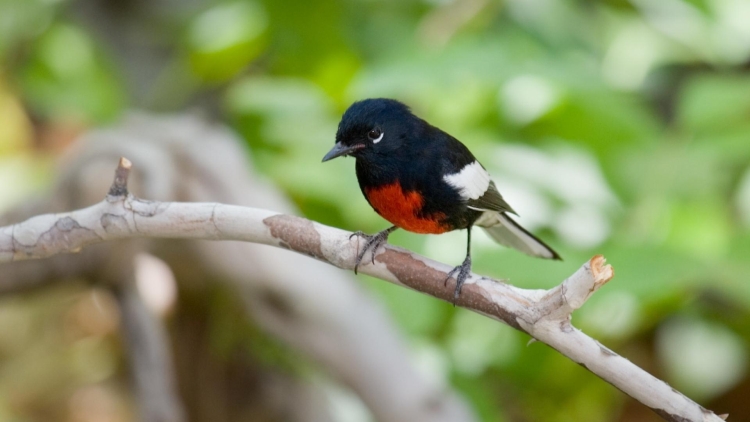
The Painted Redstart has a full, round body with long wings, a small bill, and a long black tail with white edges. They grow between 5.1 and 5.9 inches in length, weigh between 0.3 and 0.4 ounces with a wingspan of 8.3 inches. The striking Painted Redstart has a smooth black body and a bright scarlet belly, giving both male and female a formal “dressed-up” look.
They live mainly in oak trees, frequently close to water, and forage trees for insects, using their tails to flush them out.
Groove-billed Ani in California
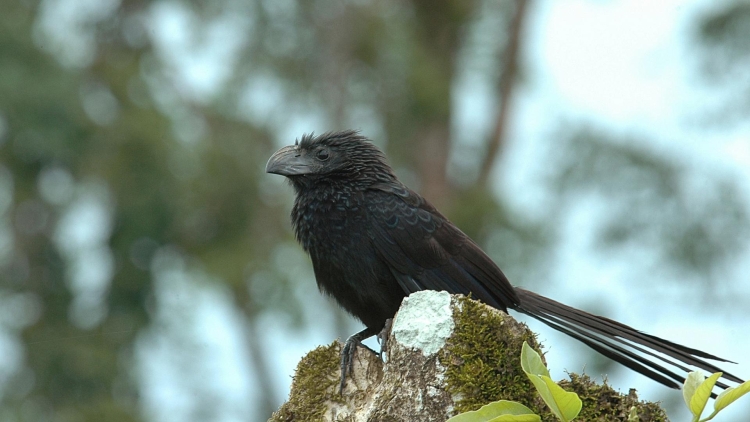
The Groove-billed Ani is a large, round bird with a heavily grooved bill. This is one of the truly black birds – there is no other shade, although the upper wings may show a greenish gloss when the light is just right. The long black, tail is half the size of its entire body. The Groove-billed Ani grows between 12 to 14 inches in length with a wingspan of 16 to 18 inches.
They live in low shrubs and/or dense vegetation, preferably in open terrain, and forage the ground for insects and lizards, or they will snatch ticks off cattle.
Yellow-billed Magpie in California
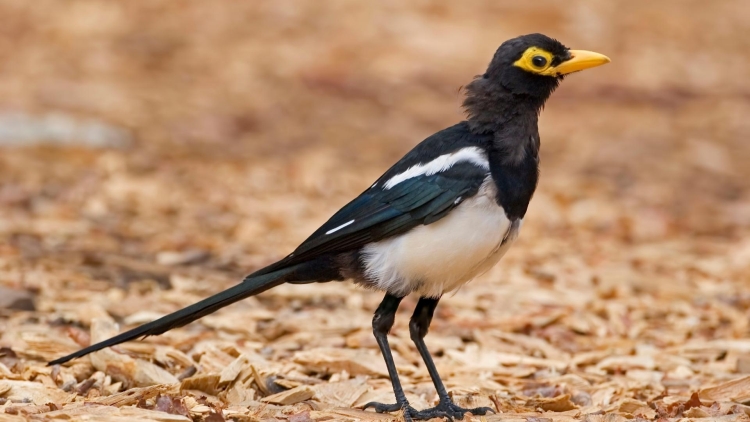
The Yellow-billed Magpie lives only in California, specifically the central and northern parts of the state. It is a large bird and a heavy body and a spectacularly long tail. They grow between 16.9 and 21.3 inches, weigh 5.3 to 6.0 ounces with a wingspan of 24 inches.
This is a black-and-white bird with a yellow bill. The back is black, and the belly is white. When it takes flight, the under feathers are revealed as white, as well, making for a startling picture.
They can be found within oak habitats, and they forage pastures, fields, and orchards for rodents, grain, or insects. They are avian thieves who will steal food from other birds and even human campers.
Blue Birds in California
Blue Scrub Jay
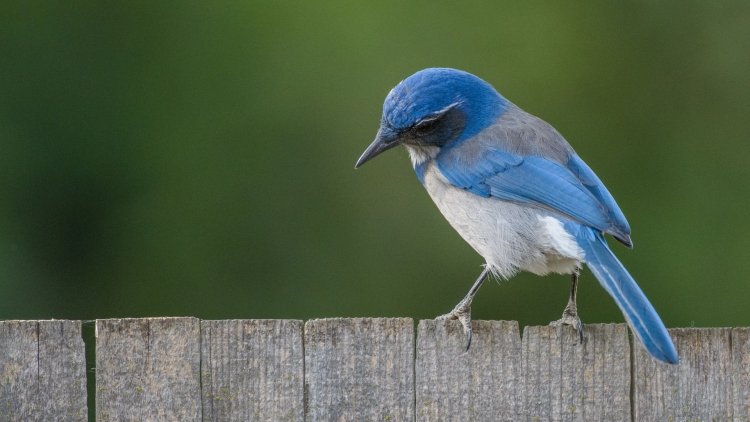
The Blue Scrub Jay is a medium-sized bluebird with a long tail and a bill with a hook. They are a rich blue and gray with a paler, white, underbelly and a jaunty crest on top of the head. The Blue Scrub Jay grows between 11.0 to 11.8 inches and weighs between 2.5 and 3.5 ounces with a wingspan of 15.3 inches.
They can be found in open terrain, parks, and chaparrals on the West Coast, as well as orchards and backyards. Their diet varies according to the season. During the summer, they feed on insects, moth caterpillars, and spiders. During the winter, they switch to nuts, acorns, the eggs of other birds, and berries.
Black-throated Blue Warbler
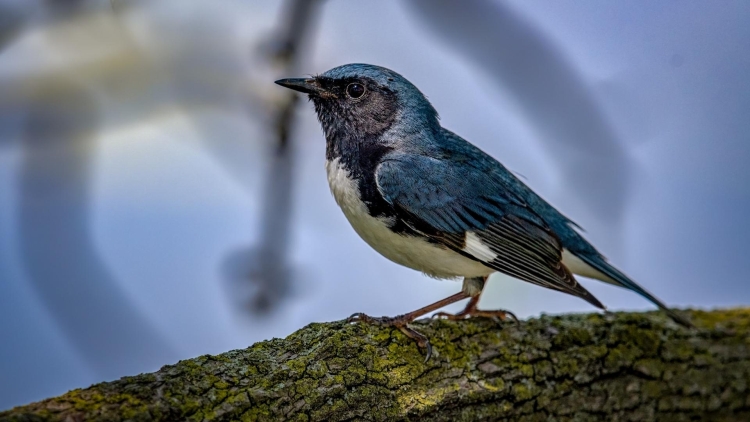
The Black-throated Blue Warbler is a large and plump bird. The male and female are so different, they were originally thought to be two different species. The male is a clear blue with a white underbelly with black marks on the throat. The female is an overall drab shade of olive. Some females have a hint of blue on their wings and tails. They both grow between 4.3 and 5.1 inches in length, weigh between 0.3 and 0.4 ounces with a wingspan between 7.5 and 7.9 inches.
Birders can catch sight of them during the winter in evergreen forests with shrubs as they forage for insects on lower tree branches.
Cerulean Warbler
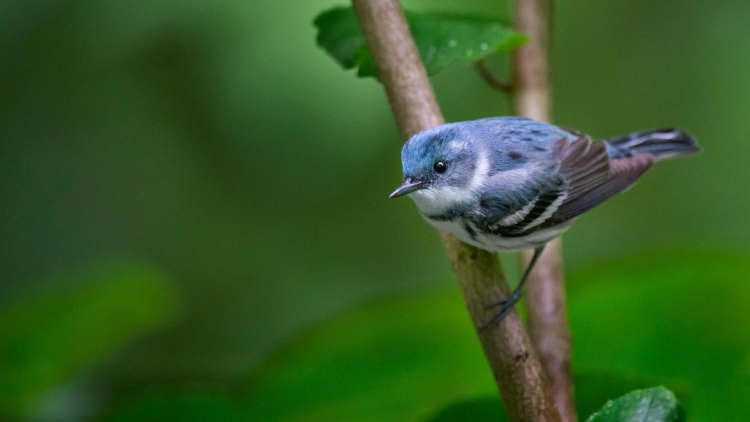
The Cerulean Warbler is a small bird with a small, round beak. The male is a lovely blue with 2 white bars across the wings, one around the neck and blue streaks along the side. The female has a greenish tinge with two wing bars but does not have the streaks on the side or the bar around the neck. They grow to 4.3 inches in length, weigh 0.3 ounces with a wingspan of 7.9 inches.
Birders craning their necks may spot the Cerulean Warbler high on top of tree canopies, up to 50 feet up, where they forage for insects. They may visit bird feeders for seeds and mealworms.
Red Birds in California
Red-winged Blackbird in California
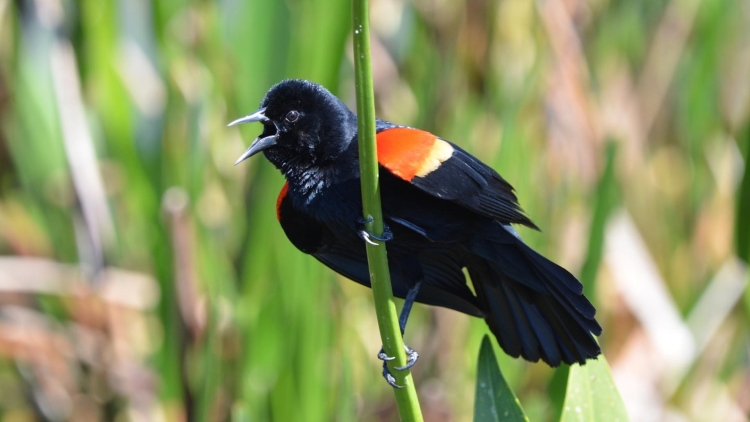
The Red-winged Blackbird can be found in California’s wetlands. They are medium-sized birds reaching 7.5 to 9.5 inches in length. The male is black with distinctive and distinguished red shoulder patches. The female has a streaked belly and a less bright red shoulder patch. Both have a thick, dark bill.
They inhabit wetlands near cattails and open habitats with willows and blackberries. Their nests are up to 6 feet above the water, or they will breed in cattails and shrubs. The Red-winged Blackbird feeds on insects and seeds during the summer and adds corn to its diet in the winter.
Summer Tanager in California
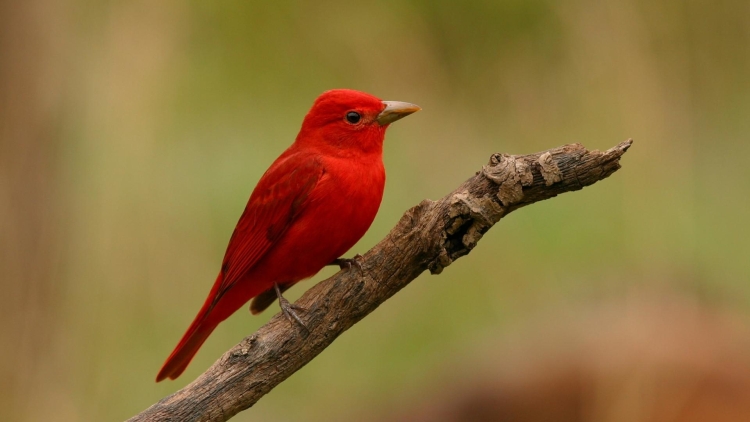
The male Summer Tanager is a striking red bird and the only fully-red bird in North America. The female, in contrast, is a dull mustard color, which helps her remain hidden within the trees. They grow to 6.7 inches in length, weigh 1.0 ounces with a wingspan of 11 inches.
They inhabit low-lying lands by streams, and they love feeding on bees and wasps and manage to do so without getting stung. They do add fruits to their diet.
Northern Cardinal in California
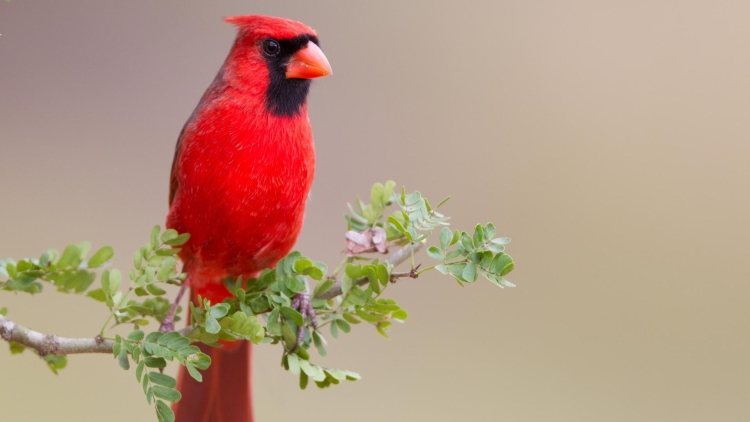
The Northern Cardinal is large, with a long tail and a short but thick bill with a noticeable high crest on the top of his head. The male is red with a black face and red bill, while the female is more brownish with a few red hints in the wings, tail, and crest. The cardinal grows between 8.3 and 9.1 inches in length, weighs between 1.5 and 1.7 inches with a wingspan of 9.8 and 12.2 inches.
They inhabit backyards, shrubby areas, and parks. They will happily come to a backyard for peanuts and sunflower seeds, as well as berries and fruits. They can be spotted in Southern California year-round.
Orange Birds in California
Barn Swallow
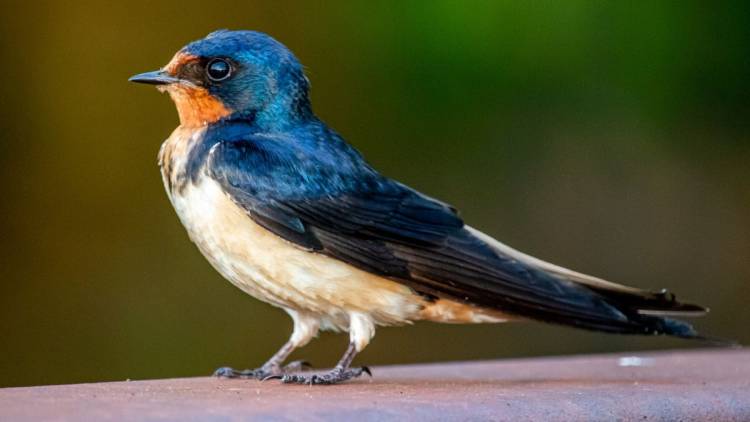
The barn swallow has broad shoulders, short feet, no neck, a somewhat flattened head, and long pointy forked wings. The Barn Swallow grows to 5.9 to 7.5 inches in length and weighs between 0.6 to 0.7 ounces with a wingspan of 11.4 to 12.6 inches. Their back is blue while their underpart and part of their face are tawny orange.
They live in open areas such as fields, parks, meadows, and near waters and feed on insects that they snap up in midair.
Red-breasted Nuthatch

The Red-breasted Nuthatch is blue-gray on top with a black cap and an orange and black stripe over the eye. The underbelly is a rich orange/cinnamon color, which is much paler on the female. Their body is plump, and they have a very short tail. They grow to 4.3 inches in length, and weigh between 0.3 and 0.5 ounces with a wingspan between 7.1 and 7.9 inches.
The Red-breasted Nuthatch lives in coniferous forests, and sometimes, they can be found in hickory or maple trees. They feed on insects such as ants, beetles, spiders, and flies during the breeding season, and they eat conifer seeds at other times.
American Redstart in California
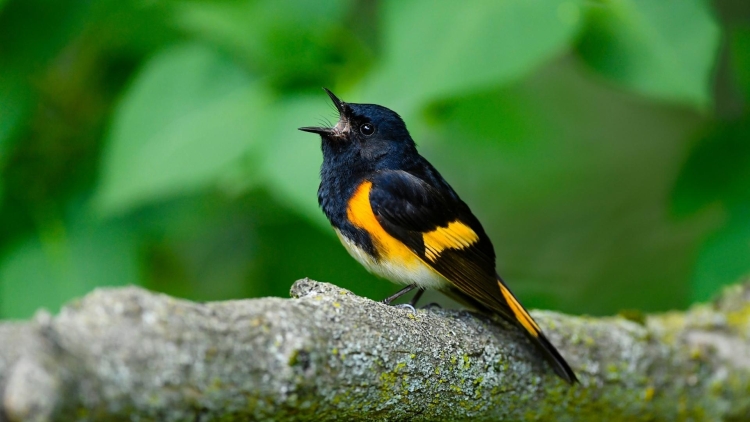
The American Redstart has a black body and head with orange patches on its wings, tail, and sides. The underbelly is white. Females have yellow patches instead of orange ones. They are a wide bird with flat bills.
Both the male and female grow between 4.3 and 5.1 inches in length, weigh between 0.2 and 0.3 ounces with a wingspan between 6.3 and 7.5 inches. They inhabit deciduous trees and hunt insects by flashing their bright tail. If the insect moves, the American Redstart will snap it up. It is the avian version of dining on the fly.
Yellow Birds in California
Yellow-rumped Warbler
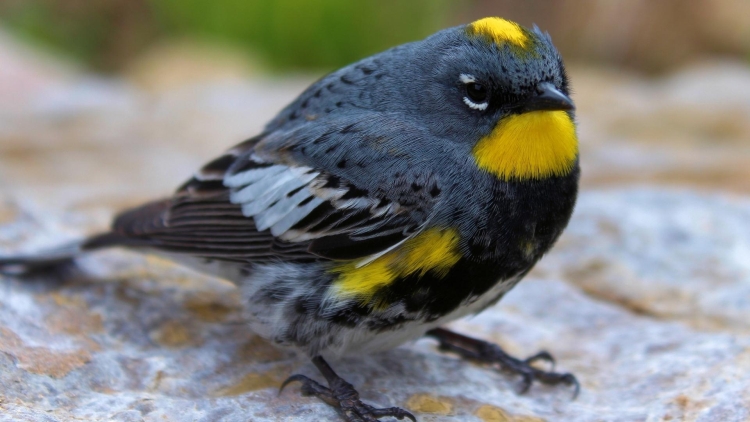
The Yellow-rumped Warbler can mostly be found during the winter in the northern part of California. They are gray with yellow on the sides and the rump. Females can be on the browner side. They grow from 4.7 to 5.5 inches in length, weigh 0.4 to 0.5 ounces with a wingspan between 7.5 to 9.1 inches.
They inhabit coniferous forests, or they can be spotted in open space during the winter. Their winter diet consists mostly of fruits and berries, while they snap up insects during the summer. They will visit backyards for sunflower seeds, raisins, suets, and everyone’s favorite – peanut butter.
Lesser Goldfinch in California
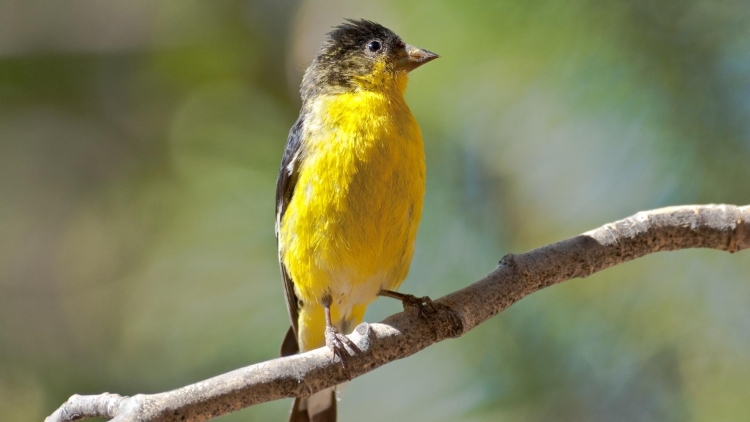
The Lesser Goldfinch lives in California all year. They are small birds with a black head and back and a bright yellow belly. Females have the same coloring but in duller, more muted shades. They grow 3.5 to 4.3 inches in length, weigh 0.3 to 0.4 ounces with a wingspan between 5.9 and 7.9 inches.
They inhabit open fields, gardens, parks, and forest clearings, where they hunt for seeds and fruits. They also feed on buds from cottonwoods, sycamores, and willows.
Common Yellowthroat
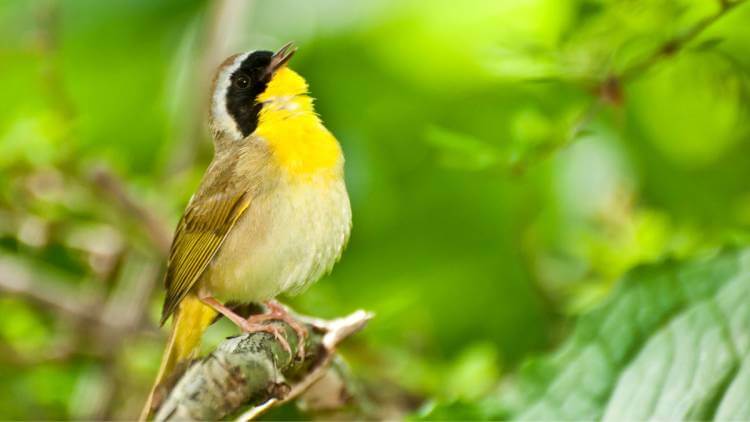
The Common Yellowthroat is a year-round California bird but can be most often spotted between April and June and between September and December. They are a small bird with a brown back, and bright yellow underpart, and a black mask with a white band covering their face. The female has the same yellow underpart, but she lacks a black mask. They grow between 4.3 and 5.2 inches, weigh 0.3 ounces with a wingspan between 5.9 and 7.5 inches.
They inhabit wetlands and areas with thick vegetation but avoid the drier area. They can frequently be heard before they are seen as they perch on a reed and burst into their distinctive song. They feed on inserts, caterpillars, flies, and beetles and will snap up some seeds.
Western Meadowlark
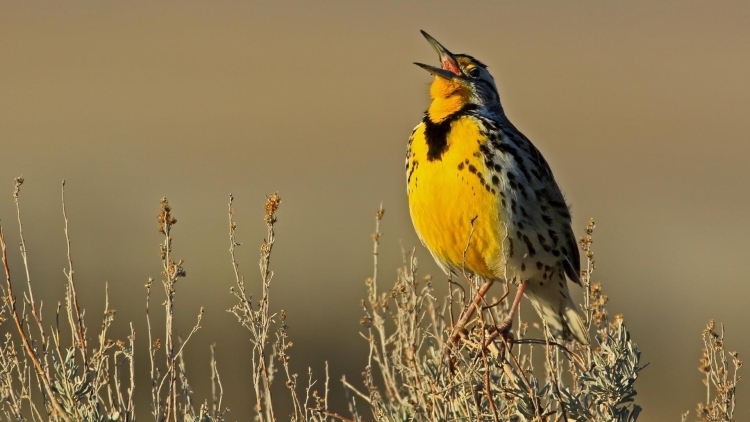
The Western Meadowlark is a year-round inhabitant of California. The best time to spot it is between October and March in the southern part of the state. They can be shades of brown, with a yellow belly and a large black V across their chest. The yellow shade turns gray during the winter. They are chunky, with a flat head, and a long bill. The Western Meadowlark grows between 6.3 and 10.2 inches and weighs 3.1 and 4.1 ounces with a wingspan of 16.1 inches.
They inhabit meadows, fields, and grassland where they forage for insects and seeds.
Common Birds by Species
Ducks
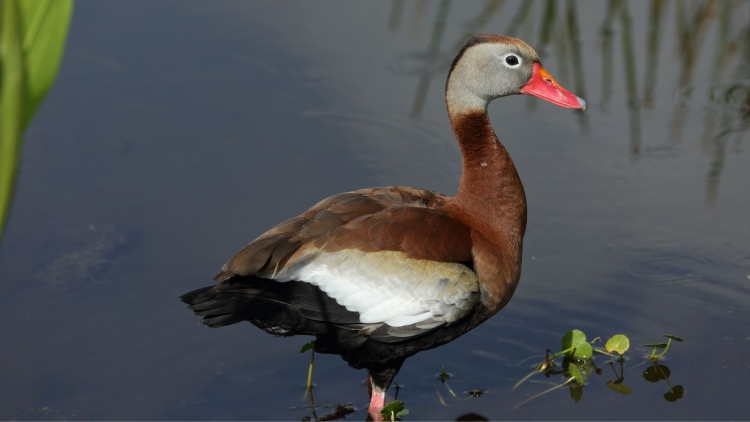
The Black-bellied Whistling Duck – Dendrocygna autumnalis – is a large duck that grows 13 inches in length with a wingspan of 37 inches. It has a long neck and long legs with a chestnut brown breast and a black belly. The bill is bright pink on a grayish face with a white eye ring. They can be found near ponds, parks, and golf courses, where they feed mostly on grain.
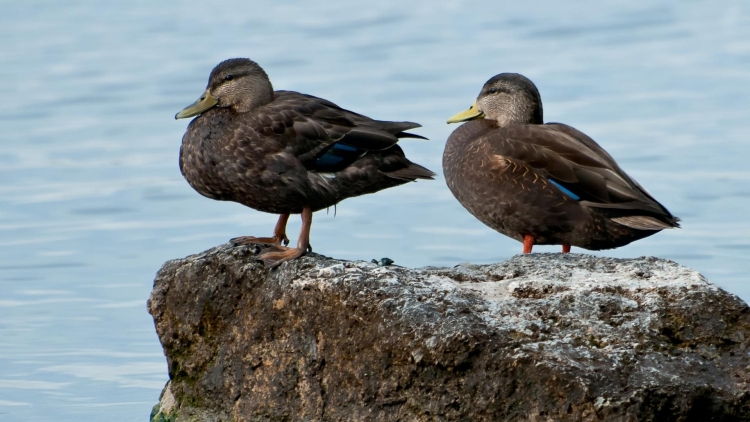
The American Black Duck – Anas rubripes – is a large bird that very much resembles the Mallards, with a round head, thick bills, and heavy-set bodies. They grow between 21.3 and 23.2 inches in length, weigh between 25.4 and 57.9 ounces with a wingspan between 34.6 and 37.4 inches. Their bodies are a dark brown, with a grayish head and yellowish bills. The American Black Duck feeds on corn and grain in fields and will grab an occasional fish. They inhabit California’s wetlands.
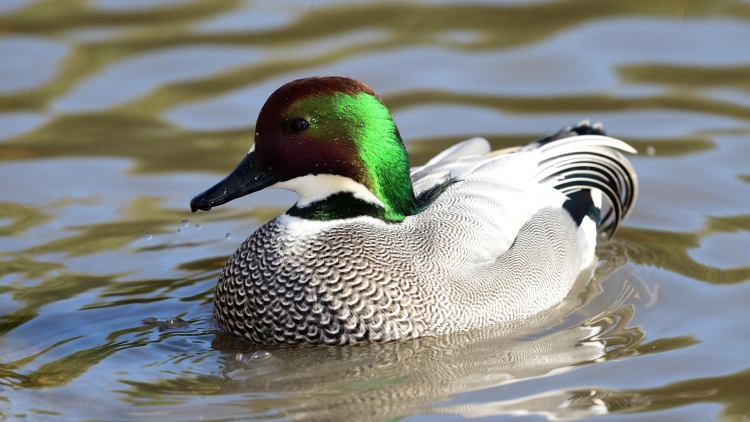
The Falcated Teal – Mareca falcata – is rare in California and birders have been searching the Colusa National Wildlife Refuge for more sightings. They grow 18 to 21 inches in length, weigh between 14.9 and 27.2 ounces with a wingspan of 31 to 36 inches. Their iridescent green and copper head is their most distinguishing feature, along with a silver body and a white patch at the throat outlined in green. They live in marshes, lakes, and wetlands, where they feed on insects, crustaceans, mollusks, seeds, grains, and plants.
Woodpeckers in California
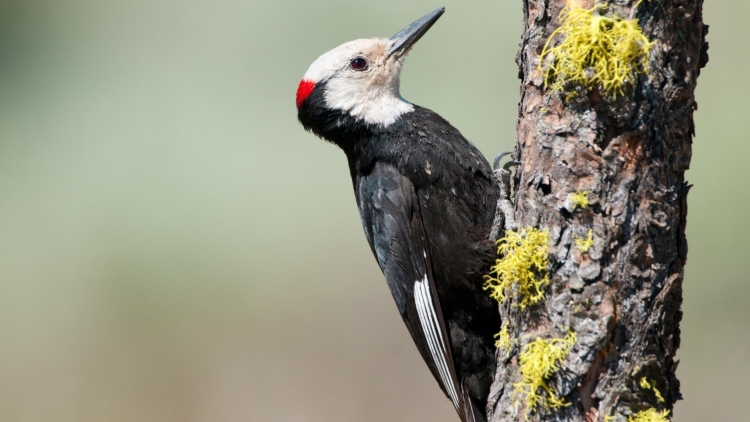
The White-headed Woodpecker – Dryobates albolarvatus – has been spotted in the Valentine Eastern Sierra Reserve. This stunning woodpecker has a black body with outer feathers and a white head with a red dot on top. They grow up to 7.9 inches in length and live in coniferous forests. Where they peck the seeds from pinecones and grab insects from trees.
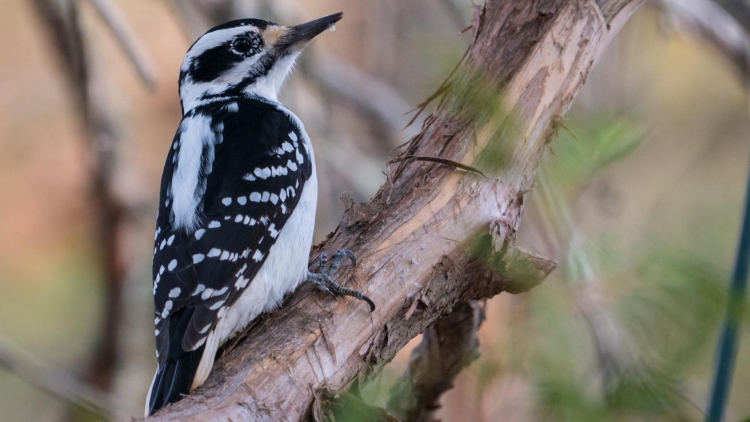
The Hairy Woodpecker – Picoides villosus – is found all year in California but they are more commonly seen during summer. They are medium-sized with black and white striped wings and a white belly. The male has a red dot on the top of his head. They grow between 7.1 and 10.2 in length, weigh 1.4 to 3.4 ounces with a wingspan between 13.0 and 16.1 inches. They are easily confused with the Downy Woodpecker.
The Hairy Woodpeckers live on trunks of trees. and feed on insects, bees, and spiders. They will visit a bird feeder for suet and sunflower seeds.
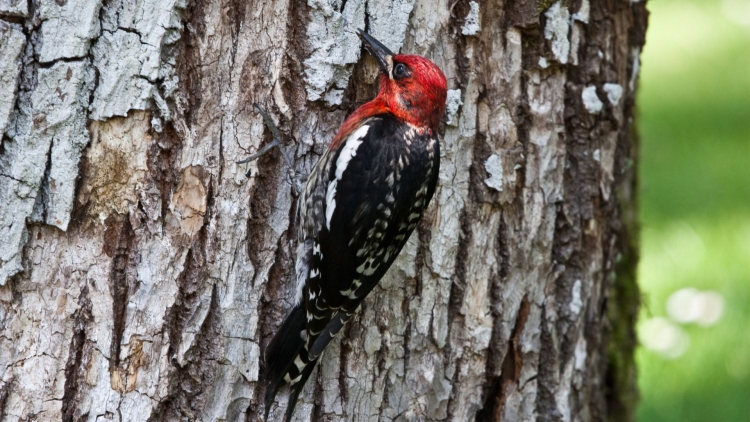
The Red-breasted Sapsucker – Sphyrapicus ruber – can be found in the piney woodlands of the Sierra Nevada. They are a medium-sized woodpecker with a red head and breast and a white line down the middle of their black wings. There is a mustache-like white spot beneath their eyes. They grow between 7.9 and 8.7 inches in length, weigh between 1.9 and 2.2 ounces with a wingspan between 14.6 and 16.0. The Red-breasted Sapsuckers inhabit coniferous forests and feed on the tree sap as well as insects and small fruits.
Hummingbirds in California
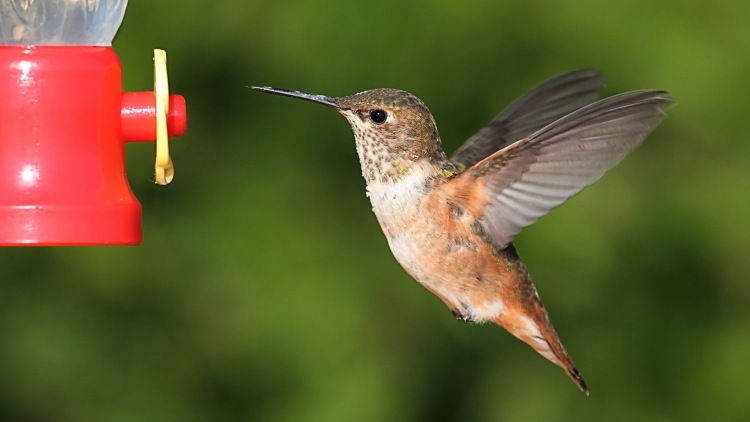
Allen’s Hummingbird – Selasphorus sasin – is a common sight in California during the summer months. Many remain in southern California throughout the year in coastal forest areas. The male has a splendid iridescent reddish throat and orange-reddish belly and tail. The female lacks the bright coloring, but both have long, straight bills and greenish backs.
They grow to 3.5 inches in length, weigh 0.1 ounces with a wingspan of 4.3 inches.
They inhabit the coastal chaparral and feed on flower nectar and insects. Sugar water will attract them to a backyard.
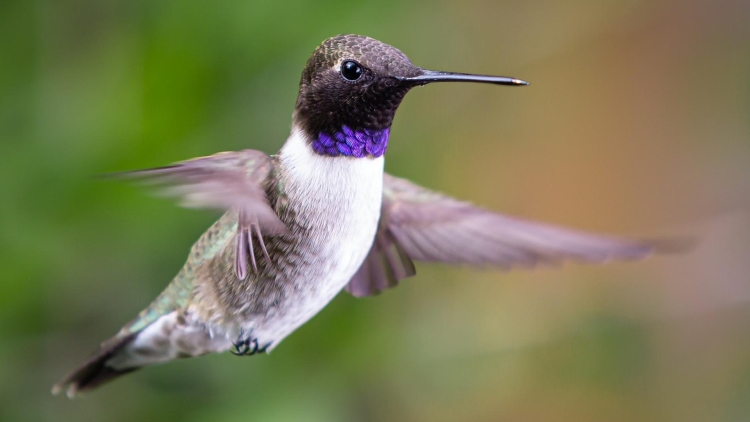
Black-chinned Hummingbirds – Archilochus alexandri – live along the coast and can be spotted between March and October. They have a metallic green back and a pale gray underside. The males have a black throat with a purple base, while the female’s throat is paler. The Black-chinned Hummingbird grows to 3.5 in length, weighs between 0.1 and 0.2 ounces with a wingspan of 4.3 inches.
They hover over flowers and will grasp at any available insect. They mostly inhabit California’s mountainous areas.
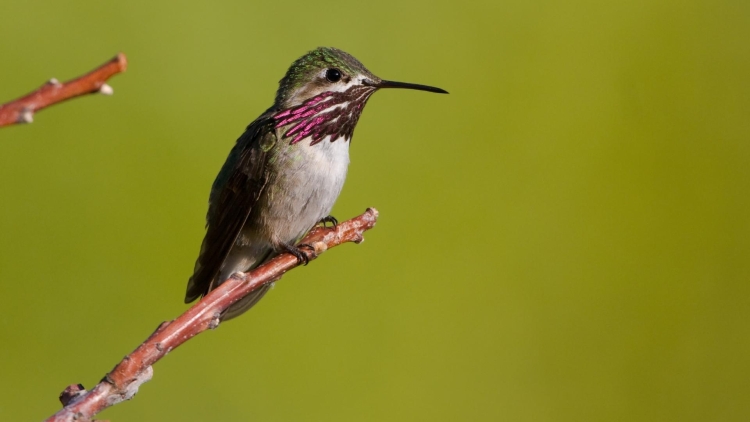
Calliope Hummingbird – Selasphorus calliope – is one of the smaller hummingbirds and can be found in northern California and the Sierra Nevada.
The Calliope Hummingbird has a greenish head and a white underbody. Both the male and the female have a short, thin bill. The male’s most prominent feature is the bright magenta patch on his throat, while the female is more peach-colored. They grow between 3.1 and 3.5 inches in length, weigh 0.1 ounces with a wingspan between 4.1 and 4.3 inches.
They inhabit meadows and thickets near streams and will drink the nectar from plants and snap up any passing insects.
Further Reading on California Birding
For more information on birding in California, consider the following guides:
- Tekiela, Stan (Author)
- English (Publication Language)
- Used Book in Good Condition
- Tekiela, Stan (Author)
These websites may also provide additional information:
Did we miss any common birds in California? Did you find the bird you’re looking for? Let us know in the comments section.


